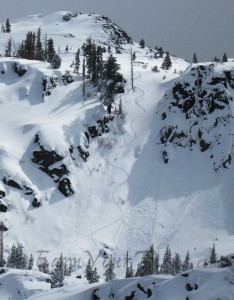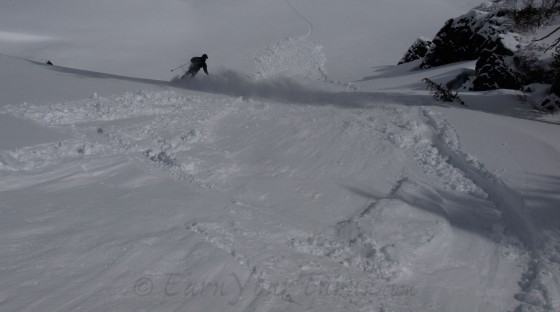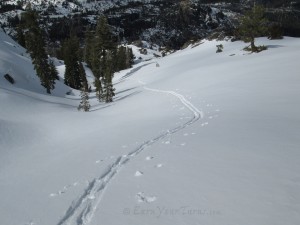Are you getting fatigued from so much avalanche safety talk these days? It’s become a media obsession to discuss ad infinitum all the nuances of being safe when skiing in the backcountry. Which begs the the question of how safe you really are if you’re having too many safety meetings. There’s a tendency to think that as long as you’re recognizing the need to be safe, you must inevitably be acting more safely.
Ironic isn’t it, the more attention we pay to safety, and safe techniques, procedures, and gadgets, the less safe we may actually be. This is a tricky line to walk here and I’m not saying that learning about the factors that cause avalanches, from the snowpack to the human trigger, isn’t beneficial, it is. But with all this knowledge available and all this discussion of the topic you’d think that our hopes of at least reducing the number of avalanche deaths would be visible, yet it’s not.
There’s plenty of evidence to suggest that the attention paid to avalanche education and preparedness is having an effect. Even though the number of fatalities steadily grows, it seems participation levels are growing much faster so the net effect is a reduction in fatalities from a percentage point of view. However, in recent conversations with a number of avalanche pros, the underlying concern is that something is wrong at the root. Perhaps it is merely our expectations, but the question of “what’s wrong” is worth pursuing on faith alone it will save some who might have perished otherwise.
Instill Fear

Calculated risk. The avalanche shown had already run, and was a point release. I went because I thought avalanche danger was low since it was fresh snow, not wind loaded, and the point release confirmed that.
Keep in mind I’m fully aware that even this does not guarantee avoidance as my own personal history can attest. I’ve done the things I’m recommending but it hasn’t prevented me from getting caught, and still remain, quite luckily, unscathed. Nonetheless I believe fear of getting caught is at the root of staying alive.
Go Solo
There are other ways to do this but the one I consider to be most easily implemented, and the one that is likely to have a lasting effect, is to tour solo. Yeah, I know, never ski alone, it’s unsafe. So is skiing with a group, and I’ll add that the evidence suggests it’s a lot less safe to ski with a group than it is to ski solo. Just consider how many avalanche fatalities occur in groups versus solo. Solo avalanche accidents are very rare.
The reason is simple; as soon as you are skiing with a group you have already started making compromises to self preservation in deference to acceptance by the group. All the Human Factors that contribute to missing obvious clues start exerting their influence and pretty soon it’s a crap shoot whether it’s you or a friend who becomes the trigger and the victim.
I’ll go out on a limb here and state unequivocally that backcountry skiing solo is safer than skiing with a group. That claim stands in stark contrast to mantra that there’s safety in numbers so here’s my rationale behind it.
First of all, it goes without saying that, unless you are suicidal, when you ski solo your instincts for self preservation will automatically kick in. When we’re with a group, we automatically allow ourselves to do things that we would only do if someone else is around, in the worst case scenario, to render first aid should we need it. Secondly, of course, is for the audience factor. I don’t know too many people hucking big solo, but plenty do it for the camera and the accolades of friends.
Setting a Safety Threshold
Now don’t mistake my recommending solo touring as a regular past time, although I’m guilty as charged. The purpose is to force yourself to understand what your baseline for safe travel is in the backcountry when you do not have a safety net of friends. What chances are you willing to take? What extra gear will you carry? What route will put you at the least risk of harm, from any number of potential hazards, including but not limited to avalanches? Unless you know what this is, how will you know how far being with a group causes you to increase the risk you’re willing to take? And if you’re simply too fearful to ski solo, what does that say about your confidence in yourself when skiing wild snow, or maybe more importantly, your willingness to put your fate in another mans hands?Two years ago there were three avalanche fatalities in the Tahoe area on two different days. On both days I was out touring solo. When I relayed this to friends they immediately accused me of being reckless. I was fully aware the avalanche potential was at least considerable, if not high. I went for a tour anyway ‘cuz I needed a workout and there just isn’t a better way. On one tour, I had in mind to ski a fairly steep pitch, but only if the snow felt stable. My meandering path took me to a mini-cornice where I could test the stability. It broke easier than expected, but didn’t trigger anything below. In theory I could probably get away with skiing the slope I wanted, but being solo, figured I better not take the chance. There would be no one to pull me out and if it ripped, I’d die from exposure if not asphyxiation. So I chose a ridge line, not the steep line for my descent and, other than soaking in the beauty of the mountains cloaked in snow and leaving a serpentine furrow in my wake, had an uneventful tour.
It might be that the first few times you head out solo you are excessively cautious. Take note. More likely you will find that you are paying much closer attention to the conditions around you, afterall, there’s no one else on the skin track to distract you with conversations about things that are far from the task at hand.
Side Effects
That’s when you might notice another benefit of the solo tour. With no audience to show off in front of, the turn ceases to be the reason you’re out there. You notice the frosted pine needles, backlit by the sun, the texture of the snow, how it compresses beneath your skis as you skin your way up, and the view from the top.
It quickly becomes clear it’s about the tour, not the turn, and that, my friends, is the best way I know to avoid getting hurt. Let the turn be your reward, but not your motivation.
© 2015
This article first appeared in Ascent Magazine Vol. I-3, a glossy, free, skiing mag. It is reprinted here by permission.
Ed. Note: A recent article in the Official Journal of Wilderness & Environmental Medicine, The Advantage of Small Groups, confirms the above opinion via studious research of existing data.



8 comments
Skip to comment form
Interesting perspective !! I related to it but I think avalanche awareness and experience are the keys to get into solo adventures.
Great piece, and as a big fan of solo travel, there’s a lot of truth to what you say. I also like the part about how the ski experience, and what the joy derives from, is different when solo.
I don’t visit the site often any more, since getting turned off by the troll-den that is your forum, but pieces like this will keep me checking back. Thanks.
80 percent of my skiing is solo out there and I feel safe or I dont ski the line the tour is THE reason and purpose and it s always calculated internally as a round trip. The new guys up there with thousands of dollars of gear and classroom certs maybe look at me increduosly but the hundreds of days and observations I have I would and dont have to ever give up. The statistic about solo avalanches is interesting. Not to say it doesnt or couldnt happen. The Utah forecaster death two years ago comes to mind. When you drill down on deaths and events leading up to deaths by avalanche in groups your points are well taken
Skiing solo eliminates so many of the ‘human factors’. People think i’m crazy for skiing solo, but I think there crazy for skiing with a group of 4,5, or 6 people.
80 percent of my skiing is solo out there and I feel safe or I dont ski the line the tour is THE reason and purpose and it s always calculated internally as a round trip. The new guys up there with thousands of dollars of gear and classroom certs maybe look at me increduosly but the hundreds of days and observations I have I would and dont have to ever give up. The statistic about solo avalanches is interesting. Not to say it doesnt or couldnt happen. The Utah forecaster death two years ago comes to mind. When you drill down on deaths and events leading up to deaths by avalanche in groups your points are well taken
I tour alone sometimes, it’s true that you may be more carefull but you fail to mention a few very important things too. These stats are from Europe, but you get my point.
– 66% of avalanche victims are only partly buried, and can be dug out by their partners. Not if you’re alone.
-Of all victims completely buried, 51% make it out alive by being dug out by their partners or mountain resque . Not if you’re alone.
-If you can get to a victim within 18 minutes, 91% survives. Not happening if you’re alone.
-Avy and being buried is not the only danger. Most victims will be severely undercooled after being dug up, in shock and possibly hurt too. You won’t make it out as easily on your own. Something like a broken leg can get real serious soon if you’re on your own too. You can’t really prevent that from happening at all.
In my opnion using Munters 3×3 method with a group, even if not all involved will be 100% commited to it, will still be safer than going solo. You may be slightly more like to get tricked, but you will also be much more likely to get out alive.
Ivar
All good points Ivar, but I stand by the tendency for extra caution when solo to minimize these possible problems. I agree, if you’re caught solo, you’re toast. The 18 minute survival window is WAY outdated. See my post (on this site) on Pascal Haegali’s report based on Canadian Avalanche statistics lowering that number to 10 minutes. If you’re lucky.
Furthermore, the point wasn’t to promote backcountry skiing solo EXCEPT has a benchmark for understanding what sort of risk you would be willing to take in a group VS solo.
But the point of skiing is fun and fun is better with friends.
So, instead of stoking my solo ego to pursue some sort of pretentious “bc mindset” I think i’ll continue to ski with friends… and I’ll have a margain for error for when i mis-judge the cohesion of storm snow, the wind’s distribution mid slope, or the steepness of a start zone… becasue i am a human and humans make errors, especially when it comes to judgment based decisions.